
Asphodelus ramosus, the branched asphodel, is a perennial herbaceous plant in the order Asparagales. Similar in appearance to Asphodelus albus and particularly Asphodelus cerasiferus and Asphodelus aestivus, it may be distinguished by its highly branched stem and smaller fruits. There has been a lot of confusion over the nomenclature and taxonomy of the species, owing to its similarity to Asphodelus aestivus.

Asphodelus is a genus of mainly perennial flowering plants in the asphodel family Asphodelaceae that was first described by Carl Linnaeus in 1753. The genus was formerly included in the lily family (Liliaceae). The genus is native to temperate Europe, the Mediterranean, Africa, the Middle East, and the Indian Subcontinent, and some species have been introduced to, and are now naturalized in, other places such as New Zealand, Australia, Mexico and southwestern United States. Many asphodels are popular garden plants, which grow in well-drained soils with abundant natural light.
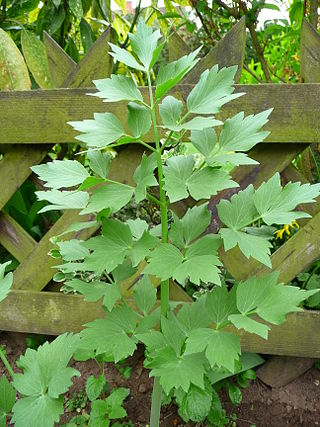
Lovage, Levisticum officinale, is a tall perennial plant, the sole species in the genus Levisticum in the family Apiaceae, subfamily Apioideae. It has been long cultivated in Europe, the leaves used as a herb, the roots as a vegetable, and the seeds as a spice, especially in southern European cuisine. Its flavour and smell are reminiscent both of celery and parsley, only more intense and spicy than either. The seeds can be used in the same way as fennel seeds.

Nelumbo lutea is a species of flowering plant in the family Nelumbonaceae. Common names include American lotus, yellow lotus, water-chinquapin, and volée. It is native to North America. The botanical name Nelumbo lutea Willd. is the currently recognized name for this species, which has been classified under the former names Nelumbium luteum and Nelumbo pentapetala, among others.

Gagea lutea, known as the yellow star-of-Bethlehem, is a Eurasian flowering plant species in the family Liliaceae. It is widespread in central Europe with scattered populations in Great Britain, Spain, and Norway to Siberia and Japan.
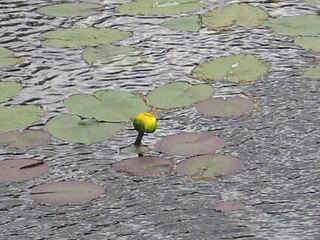
Nuphar is a genus of aquatic plants in the family Nymphaeaceae, with a temperate to subarctic Northern Hemisphere distribution. Common names include water-lily, pond-lily, alligator-bonnet or bonnet lily, and spatterdock.

Asphodelus albus, common name white asphodel, is a herbaceous perennial plant belonging to the genus Asphodelus.
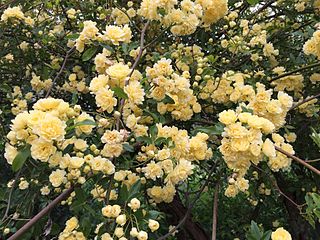
Rosa banksiae, common names Lady Banks' rose, or just Banks' rose, is a species of flowering plant in the rose family, native to central and western China, in the provinces of Gansu, Guizhou, Henan, Hubei, Jiangsu, Sichuan and Yunnan, at altitudes of 500–2,200 m (1,640–7,218 ft). The rose is named for Dorothea Lady Banks, the wife of the botanist Sir Joseph Banks.

Cladrastis kentukea, the Kentucky yellowwood or American yellowwood, is a species of Cladrastis native to the Southeastern United States, with a restricted range from western North Carolina west to eastern Oklahoma, and from southern Missouri and Indiana south to central Alabama. The tree is sometimes also called Virgilia.

Eremurus robustus, the foxtail lily or giant desert candle, is a species of flowering plant in the asphodel family, native to the Tien Shan and Pamir Mountains in Central Asia, that is often used as an ornamental plant.
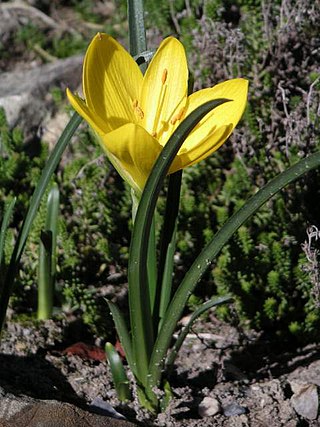
Sternbergia lutea, the winter daffodil, autumn daffodil, fall daffodil, lily-of-the-field, or yellow autumn crocus, is a bulbous flowering plant in the family Amaryllidaceae, subfamily Amaryllidoideae, in the Narcisseae tribe, which is used as an ornamental plant. It has yellow flowers which appear in autumn.

Ratibida columnifera, commonly known as upright prairie coneflower, Mexican hat, and longhead prairie coneflower, is a perennial species of flowering plant in the genus Ratibida in the family Asteraceae. It is native to much of North America and inhabits prairies, plains, roadsides, and disturbed areas from southern Canada through most of the United States to northern Mexico.

Salvia aurea is a shrubby evergreen perennial native to South Africa.

Asphodeline is a genus of perennial plants in the family Asphodelaceae, first described as a genus in 1830. It is native to the eastern Mediterranean region and the Middle East from Italy and Algeria east to Iran.
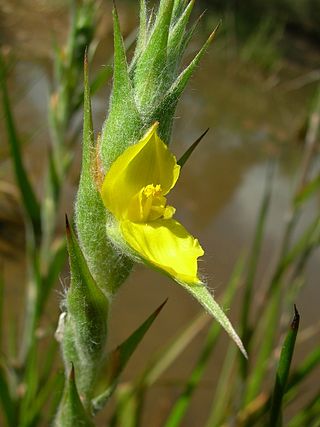
Philydrum is a genus of tufted, herbaceous, aquatic macrophyte plants, one of three genera constituting the plant family Philydraceae.
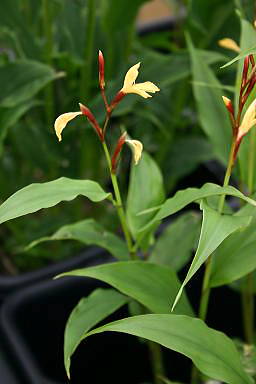
Cautleya gracilis is a perennial herbaceous plant in the family Zingiberaceae. It is found in the Himalayas through to south China and Vietnam. It is cultivated as an ornamental garden plant, hardy to a few degrees of frost.

Cautleya spicata is a perennial herbaceous plant in the family Zingiberaceae. It is found in the Himalayas through to China (Yunnan). It is cultivated as an ornamental garden plant, hardy to a few degrees of frost.

Asphodelus aestivus, the summer asphodel, is a species of asphodel, a common Western Mediterranean geophyte with a short vertical rhizome and basal leaves. Its flowers are actinomorphic, pinkish-white, with six perianth segments, 14–19 mm long and six stamens of the same length, in two whorls. Its distribution is limited to the Western Mediterranean, mainly found in Portugal and Spain on the European mainland. There has been a lot of confusion over the nomenclature and taxonomy of the species, owing to its similarity to Asphodelus ramosus. It grows in dry grasslands, phrygana and on rocky or sandy ground.

Melaleuca chisholmii commonly known as Burra bottlebrush is a plant in the myrtle family, Myrtaceae and is endemic to Queensland. It is a shrub with rough bark, an open habit and spiky foliage but in winter has bright red flower spikes tipped with yellow.

Cordia lutea, known as yellow cordia or in Spanish muyuyo, is a shrubby plant in the borage family (Boraginaceae), native to the Galápagos Islands, mainland Ecuador, Peru, and the Marquesas Islands in Polynesia. Common in the arid lowlands of the Galápagos, its relatively large yellow flowers make it easy to identify.






















